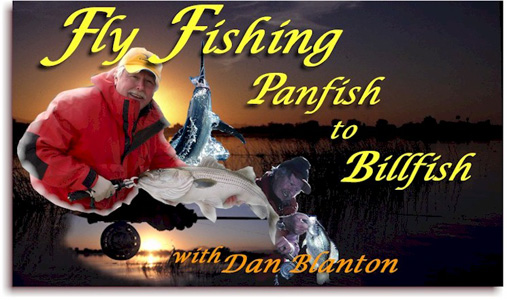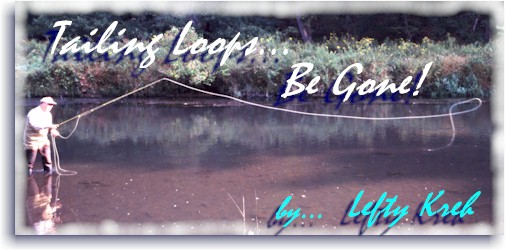Perhaps the biggest problem facing anyone who can fly cast beyond 45 feet is a tailing loop. A tailing loop is when the leader and the front of the line crash into the main line near the end of the cast. While tailing loops can occur anytime, they usually develop in a longer cast – especially when the angler makes an extra effort to gain greater distance than he or she can comfortably cast. Fortunately, anyone can eliminate tailing loops by applying a very few simple casting procedures.
Let me say that I believe just about everything I have heard and read related to the cause of a tailing loop is incorrect. The following are some of those incorrect reasons: shocking the rod; beginning the forward cast too soon: starting the forward cast too late; over powering the rod during the forward cast causing the rod tip to travel in a concave manner.
To explain what causes tailing loops and how to eliminate them, we need to understand one of the basic principles of fly-casting. All casting strokes can be divided into two parts. There is a relatively long motion in which the rod tip is gradually accelerated which loads the rod. During the final moment of the cast, there is a very brief and extremely fast acceleration, accompanied by a quick stop of the rod tip. This is often referred to as a power stroke. In reality it is a speed stroke. For the rest of this article I will refer to the power stroke as a speed up and stop.
The line is going to go in the direction that the rod tip speeds up and stops. Once we realize this, we can understand what causes tailing loops and how to correct them. A tailing loop is created when the rod tip speeds up and stops in a straight path. Straight ahead does not necessarily mean parallel to the water. It can be at any angle; the rod tip can stop going upward, parallel to the water, or down toward the surface.
The only tailing loop exception to this is if the backcast is allowed to drop so low that it travels below the rod tip throughout the forward cast. Fortunately, almost no one makes such a bad backcast. For practical purposes we can eliminate this reason.
What causes a tailing loop is somewhat similar to a house with a number of doors. You can get in the house from different directions, but you have to enter through a door. You can get a tailing loop by a number of ways, but only if the rod tip stops at the end of the cast traveling in a straight line or path.
When we cast a fly, the line unrolls in what we call a loop. AS LONG AS THE TOP OF THE LOOP REMAINS ON THE TOP AND THE BOTTOM ON THE BOTTOM—THERE WILL BE NO TAILING LOOP. Remember, on the stop the bottom of the loop is at the rod tip.
Let’s examine those often-stated incorrect reasons and why they don’t cause a tailing loop. Shocking the rod: only if you shock the rod with the tip stopping straight ahead will you get a tailing loop Shock the rod with the tip descending on the stop and there will be no tailing loop; no matter how hard you shock the rod. Beginning the forward cast too soon or overpowering the cast and starting the speed up and stop too late in the cast; all have a tendency to cause the rod tip to speed up and stop in a straight line. Many people claim that if the rod tip stops in a concave manner that a tailing loop results. But this only occurs if the rod tip stops in a straight path.
While many fly fishermen don’t realize it, you can tail the loop on the back or the forward cast and some anglers are unaware that they frequently tail the backcast. A backcast is a forward cast going in the opposite direction. What effects one will effect the other. When you make a cast in either direction, the bottom of a loop is at the tip of the rod.
How can we maintain the top of the loop on top throughout the cast to avoid a tailing loop? As the rod moves forward the line is being directed toward the rod tip. Here is how to eliminate ALL tailing loops. If the rod comes forward in a vertical plane and during the speed up and the stop, there is a slight dipping of the rod tip ON THE STOP—a tailing loop does not occur. If the rod comes forward sideways then the tip must tilt inward slightly. While there are many ways to accomplish this, if you practice the two suggestions I am going to make, you should never make a tailing loop again.
Here are the two ideas, followed by an explanation of each: (1) It is critical from the beginning to the end of the forward cast that the rod hand should travel at the same height toward the target, Beginning a cast with the hand high and dropping it at an angle short of the target is the main reason for most anglers’ tailing loops. (2) During a vertical cast the thumb must stop in a slightly downward direction. This insures that the rod tip will keep the bottom of the loop under the oncoming top portion.
To demonstrate this, throw the fly line on the ground behind you. Make a vertical cast and as the rod comes forward, be sure to keep the rod hand traveling at the same height, and during the speed up and stop, tilt the thumb slightly down and you can see how the top of the loop remains on top throughout the cast. The thumb should turn down only very slightly. Obviously, if you turn the thumb down too far you will open the loop.

